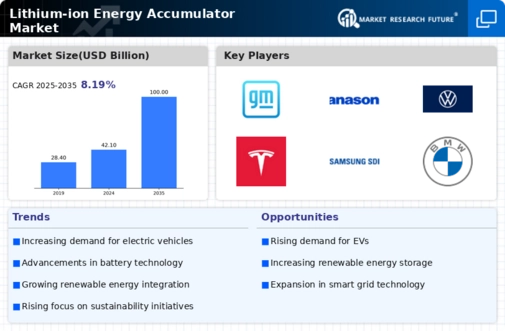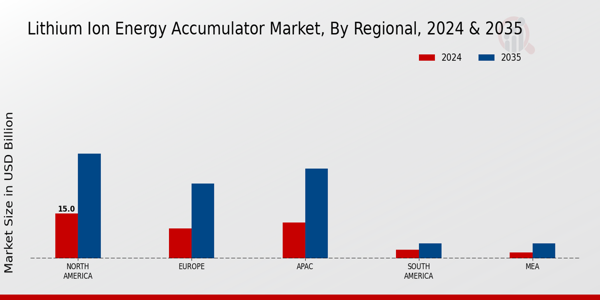Rising Demand for Electric Vehicles
The increasing adoption of electric vehicles (EVs) is a primary driver of the Global Lithium-ion Energy Accumulator Market Industry. As governments worldwide implement stringent emission regulations and provide incentives for EV purchases, the demand for lithium-ion batteries is expected to surge. In 2024, the market is projected to reach 42.1 USD Billion, with a significant portion attributed to the automotive sector. This trend is likely to continue, as the International Energy Agency forecasts that the number of electric cars on the road could reach 230 million by 2030, further propelling the growth of the lithium-ion battery market.
Government Initiatives and Regulations
Government policies and regulations aimed at promoting sustainable energy solutions are propelling the Global Lithium-ion Energy Accumulator Market Industry. Many countries are implementing initiatives to support the development and adoption of lithium-ion batteries, particularly in the automotive and renewable energy sectors. These initiatives often include financial incentives, research funding, and regulatory frameworks that encourage innovation. As a result, the market is likely to witness substantial growth, driven by supportive government actions that facilitate the transition towards cleaner energy alternatives.
Increasing Consumer Electronics Market
The burgeoning consumer electronics sector is a vital driver for the Global Lithium-ion Energy Accumulator Market Industry. With the proliferation of smartphones, laptops, and wearable devices, the demand for compact and efficient energy storage solutions is on the rise. Lithium-ion batteries are favored for their high energy density and lightweight characteristics, making them ideal for portable electronics. As the global consumer electronics market continues to expand, the lithium-ion battery market is expected to benefit significantly, reinforcing its position as a key player in the energy storage landscape.
Growth of Renewable Energy Storage Solutions
The shift towards renewable energy sources is significantly influencing the Global Lithium-ion Energy Accumulator Market Industry. As countries aim to reduce their carbon footprints, the need for efficient energy storage solutions becomes paramount. Lithium-ion batteries are increasingly utilized in solar and wind energy systems to store excess energy for later use. This trend is expected to contribute to the market's expansion, with projections indicating that by 2035, the market could reach 100 USD Billion. The integration of lithium-ion batteries in grid storage applications is likely to play a crucial role in stabilizing energy supply and demand.
Technological Advancements in Battery Technology
Innovations in lithium-ion battery technology are enhancing performance and efficiency, thereby driving the Global Lithium-ion Energy Accumulator Market Industry. Developments such as solid-state batteries and improvements in energy density are expected to increase the appeal of lithium-ion batteries across various applications. For instance, advancements in fast-charging capabilities are making these batteries more suitable for consumer electronics and electric vehicles. As a result, the market is anticipated to grow at a compound annual growth rate (CAGR) of 8.18% from 2025 to 2035, indicating a robust future for lithium-ion technology.
























Leave a Comment